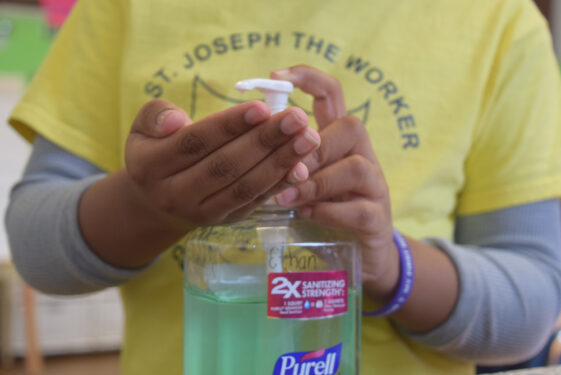How Back-to-School Means Re-Learning New Social Cues for Kids

WINDSOR TERRACE — “Wash Your Hands and Say Your Prayers Because Jesus and Germs Are Everywhere.”
That slogan, which summarizes the sentiment surrounding safety protocols and faith-based education, will greet Diocesan students as they head back to the classroom at St. Joseph the Worker Catholic Academy in Windsor Terrace.
Sixty-six Catholic schools and academies in Brooklyn and Queens plan to physically reopen under plans that allow the flexibility to either be 100 percent in-person instruction or a hybrid of distance learning. While the majority of the schools are opting to reopen at full capacity, others have chosen to hold off.
“We are opening at 50 percent capacity the first couple of days … so our teachers and our students can get comfortable to the new routines and procedures,” according to St. Joseph principal Stephanie Germann.
Germann also has concerns beyond just making sure all the surfaces in her school are sanitized from top to bottom.
“A lot of our students felt lonely at home and it’s sad,” she said. “When we think of an educational building, we think of providing solid, rigorous academics within the realm of a Catholic foundation.”
“I think kids want to go back to school because they want things to feel normal, but nothing about school is going to be normal,” Germann added.
The atmosphere at the schools is going to look and feel different. According to principal Danielle Alfeo at St. Peter’s Catholic Academy in Bensonhurst and Bath Beach, parents will not be allowed in the building, kids are mandated to wear masks, temperature checks will occur at the door, and classrooms will be capped at 15 people.
While school procedures are changing, the unknown dangers might lie deeper than the surface level for the students. School Psychologist Christina Sama-Bommarito at The Mary Louis Academy in Jamaica Estates calls COVID-19 a perfect storm for children and adolescent mental health.
“We take this event that was unpredictable and we add in these rare combinations of circumstances that drastically aggravated this event. We were surrounded by death whether it was personal to us or societal,” Sama-Bommarito said. “We had families who lost jobs … and if the child or adolescent already had pre-existing mental health issues, it kind of exacerbated that.”
“For children, even if they’re not aware as to what’s going on in society, they feel that anxiety and that depression from their parents,” she said. “It’s hard for parents not to project those feelings. Children feel that.”
When it comes to children and school, she suggests that beyond temperature checkpoints, taking note of a child’s mental health should also be on the faculty’s minds once they enter school grounds.
“Without physical connection or contact, that will be a challenge for toddlers,” Sama-Bommarito said.
“Toddlers want to hug, they want to share, but now in the classroom, teachers … they have to innovate moving to these new modalities of teaching,” she added. “They change their entire lesson plan. When you can’t pass a toy, how do you get that message across?”
According to the Centers for Disease Control and Prevention, the emotional impact of an emergency on a child depends on a child’s characteristics and experiences, the social and economic circumstances of the family and community, and the availability of local resources. Not all children respond in the same way — some might have more severe, longer-lasting reactions.
For Alfeo, she oversaw her Brooklyn academy while working at home and taking care of two toddlers by herself. During the peak of the coronavirus outbreak in New York City, her husband — who was part of the cleanup effort after 9/11 — passed away from cancer, she said. Alfeo noticed that what struck her 3-year-old daughter the hardest, on top of losing her father, was not being able to be in school while it all happened.
“When my daughter had to go on Zooms with her teacher, she was flipping out and refusing to do it,” Alfeo said. “It was a common thing that we saw across the board with all of the children, they weren’t behaving, they didn’t want to do it.”
She feels that returning to the classroom will be a relief for her and her kids who have adapted to their new norms of public health and safety precautions.
“Do they understand coronavirus and just how bad it could be? No,” she explained. “But they’re at an age that they can understand what it means to be sick and needing a mask.”
Her faculty and team members are doing their best to make the new social distancing norms and safety measures as welcoming as possible. Even though some students will be learning remotely, for those who do step into the school, rainbow-colored electrical tape will be used on the floors as borders to make sure desks are far apart and the Catholic crosses and statues will still be around for everyone to see.
“Given the circumstances of the current situation in the world right now,” Alfeo said, “I think they need to be closer to God right now. They’re probably yearning for that sense of morality right now.”








